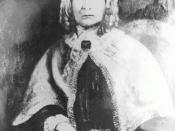a) Look at the use of poisons as a means of criminal activity and the reasons as to why it was/is so popular. Consider what has changed, when, and state the most pertinent reasons.
b) Research the Emily Perry Case. Look at the background to the charges being laid here in South Australia. Briefly outline the case as it moved through the courts. What was the final outcome? Was forensic science crucial to the case?
Part a)
Poisoning has been used as a means of criminal activity as far back as the myths and legends of the Sumerians around 4500 BC. It is the most romanticised and documented form of murder(1).
Poisoning is so horrible because it is committed in cold-blood; poison is administered hours or minutes before death. It was a popular method of killing people in the past because it could be both secretive and agonizingly slow. In times when poisons could not easily be detected or the time of consumption deduced, the murderer could flee far from the scene of the crime and out of suspicion.
Poisoning was also a popular method of committing suicide, as it could be quick and virtually painless.
By the year 82 BC poisons were such a popular way to kill oneself and others that the Emperor Sulla made a ban on using them. This did not help and the rate of death by poison increased until 100 AD.
In the early part of the first century AD, as an alarmed response to this ever more popular form of murder, Mithradates, King of Pontos, researched antidotes and drank small doses of poison daily to build up his immune system. Unlike him, not all emperors were immune to poison and by the end of the first century a number of emperors had been...


